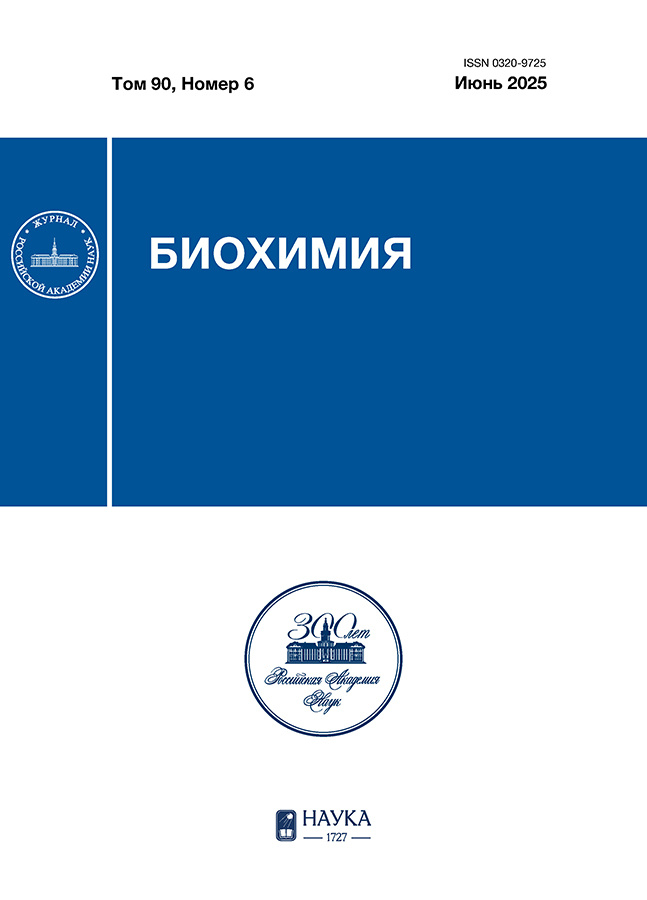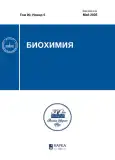FOS promoter is overactive outside of genome context and weakly regulated by changes in the Na+i/K+i ratio
- Authors: Gorbunov A.M.1, Fedorov D.A.1, Kvitko O.E.1, Lopina O.D.1, Klimanova E.A.1
-
Affiliations:
- Lomonosov Moscow State University
- Issue: Vol 90, No 5 (2025)
- Pages: 627-635
- Section: Articles
- URL: https://rjsvd.com/0320-9725/article/view/686499
- DOI: https://doi.org/10.31857/S0320972525050037
- EDN: https://elibrary.ru/IRWOKW
- ID: 686499
Cite item
Abstract
Changes in the Na+ and K+ intracellular concentrations affect expression of the FOS gene. Here, we obtained a genetic construct coding for the TurboGFP-dest1 protein under control of the human FOS promoter (−549 to +155) and studied its expression in HEK293T cells exposed to monovalent metal cations. Amplification of the FOS promoter sequence from genomic DNA was efficient only in the presence of Li+ ions. Incubation of cells with ouabain or in a medium containing Li+ ions instead of Na+ ions caused intracellular accumulation of Na+ and Li+ ions, respectively. In addition, both stimuli increased the levels of endogenous FOS mRNA and the average fluorescence intensity of TurboGFP-dest1 in transfected cells. The mRNA levels of TurboGFP-dest1 were significantly higher than the FOS mRNA levels and were little affected by the stimuli.
Keywords
Full Text
About the authors
A. M. Gorbunov
Lomonosov Moscow State University
Email: klimanova.ea@yandex.ru
Department of Biochemistry, Faculty of Biology
Russian Federation, 119234, MoscowD. A. Fedorov
Lomonosov Moscow State University
Email: klimanova.ea@yandex.ru
Department of Biochemistry, Faculty of Biology
Russian Federation, 119234, MoscowO. E. Kvitko
Lomonosov Moscow State University
Email: klimanova.ea@yandex.ru
Department of Biochemistry, Faculty of Biology
Russian Federation, 119234, MoscowO. D. Lopina
Lomonosov Moscow State University
Email: klimanova.ea@yandex.ru
Department of Biochemistry, Faculty of Biology
Russian Federation, 119234, MoscowE. A. Klimanova
Lomonosov Moscow State University
Author for correspondence.
Email: klimanova.ea@yandex.ru
Department of Biochemistry, Faculty of Biology
Russian Federation, 119234, MoscowReferences
- Skou, J. C., and Esmann, M. (1992) The Na,K-ATPase, J. Bioenerg. Biomembr., 24, 249-261, https://doi.org/10.1007/BF00768846.
- Pollack, L. R., Tate, E. H., and Cook, J. S. (1981) Turnover and regulation of Na-K-ATPase in HeLa cells, Am. J. Physiol. Cell Physiol., 241, C173-C183, https://doi.org/10.1152/ajpcell.1981.241.5.C173.
- Koltsova, S. V., Trushina, Y., Haloui, M., Akimova, O. A., Tremblay, J., Hamet, P., et al. (2012) Ubiquitous [Na+]i/[K+]i-sensitive transcriptome in mammalian cells: evidence for Ca2+i-independent excitation-transcription coupling, PLoS One, 7, e38032, https://doi.org/10.1371/journal.pone.0038032.
- Haloui, M., Taurin, S., Akimova, O. A., Guo, D.-F., Tremblay, J., Dulin, N. O., et al. (2007) [Na+]i-induced c-Fos expression is not mediated by activation of the 5′-promoter containing known transcriptional elements, FEBS J., 274, 3557-3567, https://doi.org/10.1111/j.1742-4658.2007.05885.x.
- Taurin, S., Dulin, N. O., Pchejetski, D., Grygorczyk, R., Tremblay, J., Hamet, P., et al. (2002) c-Fos expression in ouabain-treated vascular smooth muscle cells from rat aorta: evidence for an intracellular-sodium-mediated, calcium-independent mechanism, J. Physiol., 543, 835-847, https://doi.org/10.1113/jphysiol.2002.023259.
- Shiyan, A. A., Sidorenko, S. V., Fedorov, D., Klimanova, E. A., Smolyaninova, L. V., Kapilevich, L. V., et al. (2019) Elevation of intracellular Na+ contributes to expression of early response genes triggered by endothelial cell shrinkage, Cell. Physiol. Biochem. Int. J. Exp. Cell. Physiol. Biochem. Pharmacol., 53, 638-647, https://doi.org/10.33594/000000162.
- Lopina, O. D., Fedorov, D. A., Sidorenko, S. V., Bukach, O. V., and Klimanova, E. A. (2022) Sodium ions as regulators of transcription in mammalian cells, Biochemistry (Moscow), 87, 789-799, https://doi.org/10.1134/S0006297922080107.
- Wolf, B. K., Zhao, Y., McCray, A., Hawk, W. H., Deary, L. T., Sugiarto, N. W., et al. (2023) Cooperation of chromatin remodeling SWI/SNF complex and pioneer factor AP-1 shapes 3D enhancer landscapes, Nat. Struct. Mol. Biol., 30, 10-21, https://doi.org/10.1038/s41594-022-00880-x.
- Nakagawa, Y., Rivera, V., and Larner, A. C. (1992) A role for the Na/K-ATPase in the control of human c-fos and c-jun transcription, J. Biol. Chem., 267, 8785-8788, https://doi.org/10.1016/S0021-9258(19)50347-7.
- Papp, C., Mukundan, V. T., Jenjaroenpun, P., Winnerdy, F. R., Ow, G. S., Phan, A. T., et al. (2023) Stable bulged G-quadruplexes in the human genome: identification, experimental validation and functionalization, Nucleic Acids Res., 51, 4148-4177, https://doi.org/10.1093/nar/gkad252.
- Sen, D., and Gilbert, W. (1990) A sodium-potassium switch in the formation of four-stranded G4-DNA, Nature, 344, 410-414, https://doi.org/10.1038/344410a0.
- Klimanova, E. A., Sidorenko, S. V., Abramicheva, P. A., Tverskoi, A. M., Orlov, S. N., and Lopina, O. D. (2020) Transcriptomic changes in endothelial cells triggered by Na,K-ATPase inhibition: a search for upstream Na+i/K+i sensitive genes, Int. J. Mol. Sci., 21, 7992, https://doi.org/10.3390/ijms21217992.
- Chashchina, G. V., Beniaminov, A. D., and Kaluzhny, D. N. (2019) Stable G-quadruplex structures of oncogene promoters induce potassium-dependent stops of thermostable DNA polymerase, Biochemistry (Moscow), 84, 562-569, https://doi.org/10.1134/S0006297919050109.
- Fedorov, D. A., Sidorenko, S. V., Yusipovich, A. I., Bukach, O. V., Gorbunov, A. M., Lopina, O. D., et al. (2022) Increased extracellular sodium concentration as a factor regulating gene expression in endothelium, Biochemistry (Moscow), 87, 489-499, https://doi.org/10.1134/S0006297922060013.
- Lowry, O. H., Rosebrough, N. J., Farr, A. L., and Randall, R. J. (1951) Protein measurement with the Folin phenol reagent, J. Biol. Chem., 193, 265-275.
- Livak, K. J., and Schmittgen, T. D. (2001) Analysis of relative gene expression data using real-time quantitative PCR and the 2−ΔΔCT method, Methods, 25, 402-408, https://doi.org/10.1006/meth.2001.1262.
- Ablasser, A., Bauernfeind, F., Hartmann, G., Latz, E., Fitzgerald, K. A., and Hornung, V. (2009) RIG-I-dependent sensing of poly(dA:dT) through the induction of an RNA polymerase III-transcribed RNA intermediate, Nat. Immunol., 10, 1065-1072, https://doi.org/10.1038/ni.1779.
- Koelsch, K. A., Wang, Y., Maier-Moore, J. S., Sawalha, A. H., and Wren, J. D. (2013) GFP affects human T cell activation and cytokine production following in vitro stimulation, PLoS One, 8, e50068, https://doi.org/10.1371/journal.pone.0050068.
- Collart, M. A., Tourkine, N., Belin, D., Vassalli, P., Jeanteur, P., and Blanchard, J. M. (1991) c-fos gene transcription in murine macrophages is modulated by a calcium-dependent block to elongation in intron 1, Mol. Cell. Biol., 11, 2826-2831, https://doi.org/10.1128/mcb.11.5.2826-2831.1991.
- Mechti, N., Piechaczyk, M., Blanchard, J. M., Jeanteur, P., and Lebleu, B. (1991) Sequence requirements for premature transcription arrest within the first intron of the mouse c-fos gene, Mol. Cell. Biol., 11, 2832-2841, https://doi.org/10.1128/mcb.11.5.2832-2841.1991.
- Coulon, V., Veyrune, J. L., Tourkine, N., Vié, A., Hipskind, R. A., and Blanchard, J. M. (1999) A novel calcium signaling pathway targets the c-fos intragenic transcriptional pausing site, J. Biol. Chem., 274, 30439-30446, https://doi.org/10.1074/jbc.274.43.30439.
- Yamada, T., Yamaguchi, Y., Inukai, N., Okamoto, S., Mura, T., and Handa, H. (2006) P-TEFb-mediated phosphorylation of hSpt5 C-terminal repeats is critical for processive transcription elongation, Mol. Cell, 21, 227-237, https://doi.org/10.1016/j.molcel.2005.11.024.
Supplementary files















